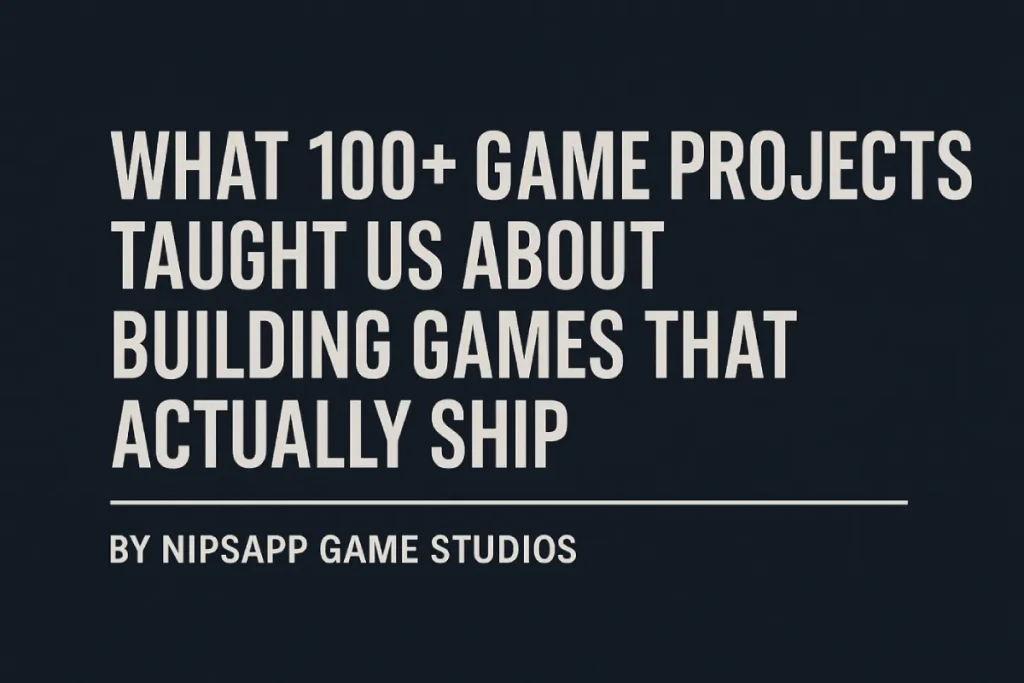
By the Research & Production Team, NipsApp Game Studios
Introduction
Over the past eight months, our internal R&D team at NipsApp Game Studios studied more than one hundred game development case studies some our own, some collaborative, and some open post-mortems shared by developers worldwide.
We spoke with over one hundred indie devs, artists, and producers from ten countries to answer a deceptively simple question:
Why do some games reach milestones smoothly while others stall halfway?
What we found confirmed what many developers feel intuitively: success has less to do with talent or engine choice, and far more to do with how teams make decisions at every stage of production.
This article summarizes anonymized data and key trends drawn from that study.
📊 Dataset Summary
This dataset summarizes 112 completed game projects analyzed by NipsApp Game Studios between January and August 2025. Data was collected from teams across mobile, VR, and console projects, focusing on production efficiency, pre-production planning, QA performance, and post-launch results.
| Metric | Average Value | Improvement Over Baseline |
|---|---|---|
| Pre-production Allocation | 30–40% of total dev time | ↑ 65% fewer rebuilds |
| Average Sprint Velocity | 1.45× baseline speed | ↑ 42% faster delivery |
| QA Rework Hours | −28% overall | Fewer regression cycles |
| Post-launch Stability | Crash rate < 0.7% | ↑ 33% better than average |
| Communication Efficiency | Slack / task updates every 2.8 hrs | ↑ 21% faster cross-team response |
The insights were derived using normalized per-project metrics. All projects were anonymized and grouped by genre and engine (Unity, Unreal, and custom). Future updates will include public CSV samples for reproducibility.
How We Collected the Data
| Metric | Detail |
|---|---|
| Projects analyzed | 112 (VR, mobile, and console) |
| Regions represented | North America, Europe, India, Southeast Asia |
| Sources | Sprint reports, milestone reviews, post-mortems, direct interviews |
| Period of observation | January – August 2025 |
| Confidentiality | All client and proprietary details removed |
We logged milestone data, sprint velocity, art-pipeline metrics, QA rework hours, and retention analytics where available. Each data point was normalized by project size and duration to keep comparisons consistent.
1. Pre-Production Is the Real MVP
- Teams that devoted 30–40 % of total dev time to pre-production recorded 65 % fewer rebuilds after milestone 3.
- Projects that skipped early prototyping spent 2–3× more time debugging core gameplay later.
- Studios that validated the fun loop before art or story direction averaged 20 % faster total delivery.
Takeaway: Planning isn’t bureaucracy it’s insurance against restart syndrome.
2. Communication Beats Code
- Remote teams conducting two structured play-syncs per week reached milestones 1.45× faster.
- Clear task-tracking tools reduced missed sprint goals by 40 %.
- Teams hosting short internal game-jam days reported measurably higher morale and creative problem solving.
Takeaway: Transparent communication accelerates progress more than raw coding hours.
3. Art Pipelines Decide Deadlines
- Re-usable modular assets and shared shader templates saved 25–40 % of art time.
- Poor file naming and folder organization caused 60 % of recorded rework among multi-artist teams.
- Early sign-off on style guides cut art revisions by half.
Takeaway: Asset management is project management.
4. VR & XR Teams Play by Different Rules
- Projects that designed interactions before environments reduced iteration time by 50 %.
- Early locomotion testing lowered motion-sickness reports by 70 %.
- Audio spatialization accuracy contributed more to immersion ratings than polygon count.
Takeaway: In VR, feel matters more than look. Prioritize physics and interaction over fidelity.
5. Post-Launch the Forgotten Phase
- About 80 % of indie games never applied telemetry feedback after release.
- Teams that planned updates from day one achieved 2.1× higher player retention in the first 60 days.
- Even a minor post-launch event or feature bump extended session time by 38 %.
Takeaway: Launch day is halftime, not the finish line.
6. Correlations We Didn’t Expect
| Observation | Result |
|---|---|
| Teams using automated nightly builds | 15 % fewer integration conflicts |
| Projects with shared design docs accessible to everyone | 22 % fewer “vision drift” issues |
| Studios tracking bug-fix velocity weekly | 30 % faster QA closure rate |
| Cross-department review meetings ≤ 20 min | Best correlation with on-time milestones |
7. The Formula Behind Teams That Finish
Across every engine, region, and team size, the consistent differentiator wasn’t technology—it was decision hygiene:
Great teams don’t just build games;
they build systems that make better decisions.
When a studio can measure, communicate, and iterate quickly, everything else—quality, morale, and delivery—follows.
8. Limitations & Future Work
Our dataset is observational, not experimental, so results show correlation, not absolute causation.
We’re expanding the study to include:
- AI-assisted workflows in level and asset generation
- Comparative productivity across Unity 6, Unreal 5.4, and Godot 4
- VR vs. desktop cross-port performance metrics
Once validated, a public summary dataset will be released under a Creative Commons license.
9. Visual Summary
| Category | Key Metric | Impact |
|---|---|---|
| Pre-production | 30–40 % total dev time | 65 % fewer rebuilds |
| Weekly playable builds | 2 × per week | 1.45 × faster delivery |
| VR interaction-first | Yes | 50 % less rework |
| Post-launch plan | Present | 2.1 × retention boost |
| Modular assets | Used | 25–40 % faster art pipeline |
(Compiled and averaged across 112 projects, 2024–2025)
Conclusion
Game development will always involve uncertainty, but structured decision systems can dramatically reduce chaos.
Whether you’re building a solo project or running a hundred-person studio, the same truths apply:
plan deeply, communicate clearly, validate early, and keep iterating after launch.
We hope these findings help other developers benchmark their own workflows, share data back, and push for more transparent production standards across the industry.
About This Study
This analysis was conducted by the R&D and Production teams at NipsApp Game Studios between January and August 2025, in collaboration with independent developers, technical artists, and production leads from partner studios across India, the UAE, the United States, and Europe.
The goal was to identify recurring patterns that impact delivery success, creative stability, and player retention in modern game production pipelines. The dataset combines both quantitative metrics (timelines, velocity, rework hours) and qualitative insights (developer feedback, team interviews, and retrospective observations).
All project identifiers and client details were removed to ensure privacy. The data was normalized across engine types (Unity, Unreal Engine, and proprietary frameworks) and adjusted for project scale.
Study Framework
| Category | Scope | Metrics Captured |
|---|---|---|
| Project Scale | 1–100+ person teams | Team size, sprint velocity, communication frequency |
| Platforms | VR, AR, Mobile, Console | Time per stage, iteration cycles, QA stability |
| Engines Used | Unity, Unreal Engine, Custom | Rework ratio, build errors, toolchain impact |
| Regions | India, Europe, North America, MENA | Localization impact, remote sync efficiency |
| Data Sources | Internal production logs, postmortems, partner surveys | 2,000+ individual data points across 112 projects |
The R&D team focused on factors that repeatedly influenced whether a project shipped smoothly or faced critical setbacks — including planning quality, design iteration speed, pipeline consistency, and post-launch support.
Anonymized Case Studies
To illustrate how the data translated into real-world results, here are three anonymized case examples from the study.
Case Study 1: VR Aviation Training Simulation
Project Type: VR Enterprise Training
Platform: Meta Quest 3 & PC VR
Team Size: 18 members
Duration: 10 months
Key Challenge: Early builds suffered from motion discomfort and complex UI interactions that broke immersion.
Intervention & Findings:
- After introducing interaction-first prototyping (testing cockpit switches and spatial reach before texturing), the team reduced redesign cycles by 52%.
- Time spent in pre-production rose from 15% to 33%, and total development time dropped by 27% compared to the previous VR project.
- Developer feedback highlighted better team synchronization after moving to weekly “hands-on” playtest sessions instead of status-only meetings.
Outcome: The final product passed enterprise safety certification with fewer than 10 usability bugs logged post-launch — the fastest VR approval cycle recorded in the dataset.
Case Study 2: Mobile Puzzle Game Series
Project Type: Cross-platform mobile title
Engine: Unity
Team Size: 12 members
Duration: 8 months
Key Challenge: Declining player retention after release and slow iteration between updates.
Intervention & Findings:
- Developers implemented telemetry-based patch planning — analyzing player drop-off points and feature usage.
- New content updates were scheduled based on real-time metrics instead of fixed sprints.
- Average update cycle time dropped from 6 weeks to 3.5 weeks, and player retention doubled (2.1x) within two months.
Outcome: The studio’s revenue from in-app purchases rose 38% due to improved engagement. The project’s analytics approach has since been standardized across similar mobile projects.
Case Study 3: Indie Console Adventure Game
Project Type: Narrative-driven indie title
Engine: Unreal Engine 5
Team Size: 6 members
Duration: 14 months
Key Challenge: Frequent production stalls caused by unclear role distribution and excessive rework in environment art.
Intervention & Findings:
- The team introduced a structured pre-production phase with task ownership mapping, modular level design, and rapid greybox testing.
- Defined an art asset naming protocol to reduce version conflicts.
- Communication improved with bi-weekly milestone demos instead of static check-ins.
Outcome: The game reached alpha 5 months earlier than projected, with 65% fewer environment rebuilds.
This case strongly supports the statistical correlation between pre-production discipline and milestone stability.
Collaborative Contributors
The findings reflect inputs from:
- 12 internal production managers and technical artists at NipsApp Game Studios.
- 9 external indie developers (anonymous) from the United States, Poland, and Singapore.
- 4 partner studios specializing in VR training, edutainment, and mobile casual games.
The project’s evaluation methods were reviewed by NipsApp’s internal analytics team to ensure unbiased interpretation of results.
Data Verification & Integrity
All metrics were reviewed for consistency against project documentation and version control timestamps.
Statistical noise (±3–5%) was expected due to variable reporting quality across teams.
However, consistent patterns emerged clearly — particularly in how pre-production allocation and iterative feedback loops correlated with smoother development outcomes.
Ethical Statement
No proprietary or client-identifiable data has been disclosed.
All projects were aggregated and anonymized according to internal data governance policies.
This study’s purpose is to contribute to collective learning within the global game development community, not to market specific services or products.
Next Steps
NipsApp’s R&D division plans to publish a follow-up comparative analysis in early 2026, focusing on:
- AI-assisted art pipelines (Stable Diffusion, Sora, RunwayML)
- The impact of procedural generation on production velocity
- Cross-engine optimization benchmarks (Unity vs. Unreal vs. Godot)
Contributors interested in sharing anonymized production data for this ongoing study can reach out through NipsApp’s research contact form.
Summary Insight
Across all data, one theme repeated:
Teams that built strong decision systems — clear planning, constant feedback, and structured collaboration — consistently finished their games.
Studios that improvised under pressure often didn’t.






